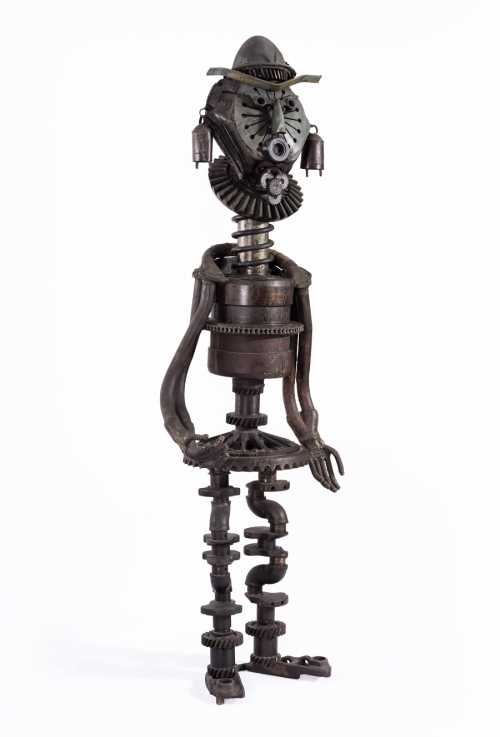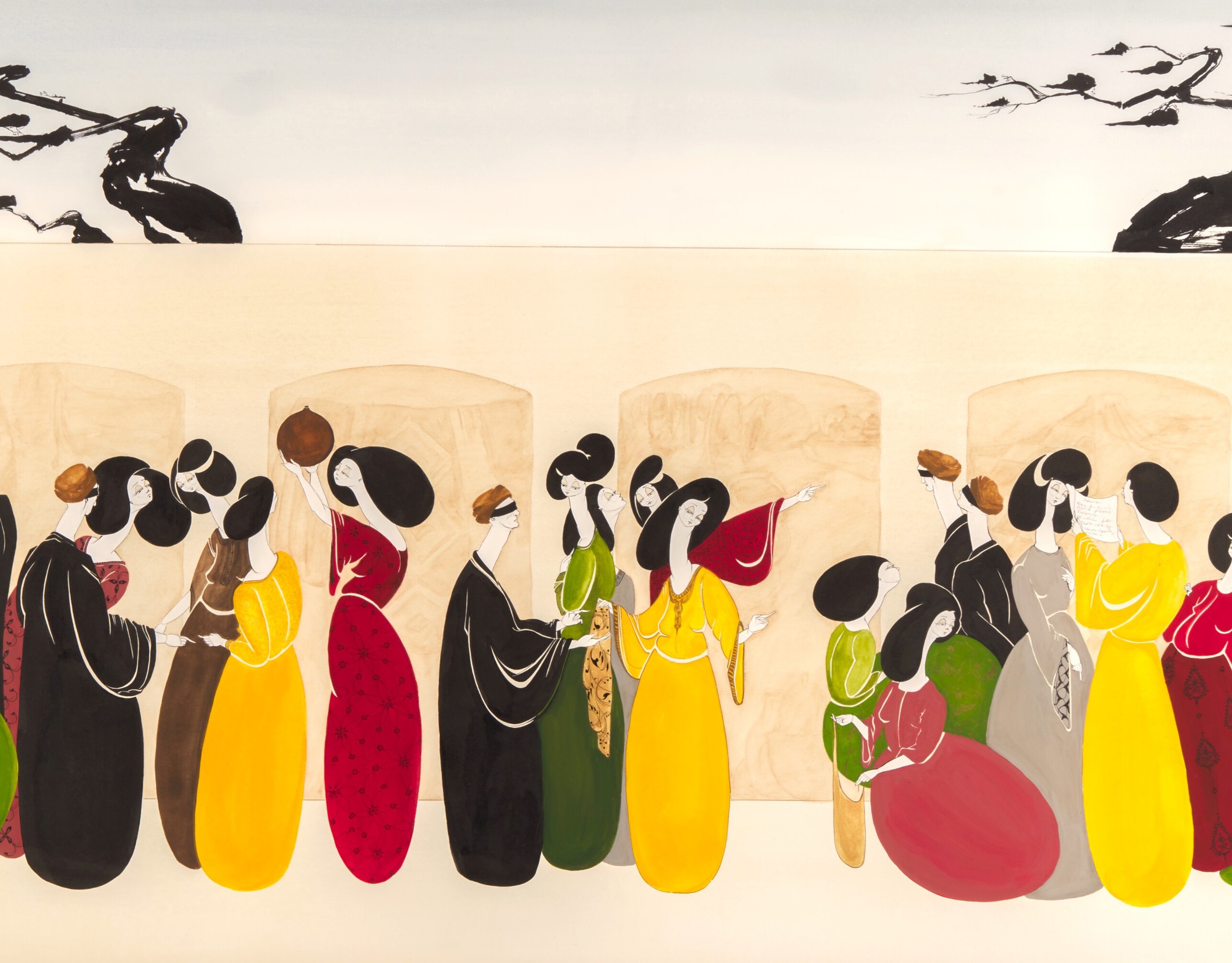About Jazeh Tabatabai
Jazeh Tabatabai, originally known as Ali Tabatabai, was a multifaceted artist celebrated for his sculptures. He began writing at the age of 12 and was deeply engrossed in writing and painting during his teenage years, holding his first painting exhibition at just 19.
His artistic journey encompassed directing, painting, and sculpture from a young age. In 1954, he enrolled in the directing and theater program at university, staging the play "Sailor's Shirt." By 1960, Tabatabai completed his painting studies at the Faculty of Fine Arts, University of Tehran, concurrently establishing the Honar-e Jadid Gallery. His artworks, including paintings and sculptures, are housed in significant museums and collections such as the Tehran Museum of Contemporary Art, Louvre Museum, and Metropolitan Museum.
Jazeh Tabatabai's primary artistic concern centered on a patriotic narrative across various art forms—painting, sculpture, poetry, and writing. His profound affection for Iranian culture permeated his creations, with figurative metal sculptures standing out as pivotal in his oeuvre. During a phase of his career, he transformed industrial machinery waste into figures that exuded a soulful presence despite their austere appearance.
Reflecting on his diverse artistic experiences, Jazeh Tabatabai remarked, "One day I am a writer, and the next a painter; I wake up and perceive the world differently each day, with an enduring flame inside me. It's enough to have perception; the form of expression will find its way."
His artistic journey encompassed directing, painting, and sculpture from a young age. In 1954, he enrolled in the directing and theater program at university, staging the play "Sailor's Shirt." By 1960, Tabatabai completed his painting studies at the Faculty of Fine Arts, University of Tehran, concurrently establishing the Honar-e Jadid Gallery. His artworks, including paintings and sculptures, are housed in significant museums and collections such as the Tehran Museum of Contemporary Art, Louvre Museum, and Metropolitan Museum.
Jazeh Tabatabai's primary artistic concern centered on a patriotic narrative across various art forms—painting, sculpture, poetry, and writing. His profound affection for Iranian culture permeated his creations, with figurative metal sculptures standing out as pivotal in his oeuvre. During a phase of his career, he transformed industrial machinery waste into figures that exuded a soulful presence despite their austere appearance.
Reflecting on his diverse artistic experiences, Jazeh Tabatabai remarked, "One day I am a writer, and the next a painter; I wake up and perceive the world differently each day, with an enduring flame inside me. It's enough to have perception; the form of expression will find its way."
The Most Expensive Artwork
At Auctions
First Attendance
24 November 2008
# Attendance
56
# Artworks
89
Average Realized Price
33,886 USD
Average Min Estimate
23,357 USD
Average Max Estimate
32,668 USD
Sell-through Rate
77.647%
Average Growth of Artwork Worth
30.673%
Timeline
Fine Art: 19th Century to Modern, Icons & Eastern European Masters auction
9 December
15th October - Contemporary Art auction
15 October
The 24th Tehran - Contemporary Iranian Art auction
3 October
20th and 21st Century Fine Art & Furniture auction
2 October
Middle East / 20th Century Art / n°21 auction
6 July
No. 72 auction
11 June
Shadow exhibition
18 April
On the Path of Iranian Art History exhibition
4 April
The 22nd Tehran - Modern, Classic and Traditional Iranian Art auction
14 February
Modern and Contemporary Collector exhibition
7 February
Modern and Contemporary Middle Eastern Art auction
13 November
Timeless Creation exhibition
25 October
The 21st Tehran - Contemporary Iranian Art auction
11 October
Saqqakhaneh, the Birth of a Dream exhibition
13 September
"Bitter, Sweet, Burden" Iranian Perspective, Three Views exhibition
9 August
Decades Projects 1300-1310 exhibition
2 August
The 20th Tehran- Modern and Contemporary Iranian Art auction
5 July
A Collection exhibition
10 May
Modern & Contemporary Middle East auction
25 April
Connoisseur's Look exhibition
19 April
10s of Artworks, 10s of Millions exhibition
8 March
The Artwork of Legendary Artists exhibition
9 February
The 19th Tehran -Classic and Modern Iranian Art auction
24 January
Modern Collectore exhibition
19 January
Collector - Modern exhibition
29 September
A Selection of 70 Years of Iranian Sculpture exhibition
4 August
Beirut-Paris Part II - Middle Eastern Art Online Sale auction
24 July
The 17th Tehran Modern and Contemporary Iranian Art auction
18 July
Contemporary Art auction
7 June
Intersect 01 exhibition
19 May
Recovery/ The third series exhibition
10 March
Fine Art auction
8 March
Middle Eastern Modern and Contemporary Part II auction
20 December
Fine Art auction
29 October
Treasure 1 exhibition
22 July
Fine Art - Paintings & Works on Paper from Old Masters to Contemporary Art, East European Art, Faberge, Icons auction
26 June
Modern Collector exhibition
24 June
Fine Art, Design and Objects of Vertu auction
26 March
Fine Art, Design and Objects of Vertu auction
16 March
Last Chapter exhibition
25 February
The last event 1400 exhibition
25 February
The 15th Tehran- Modern Iranian Art auction
14 January
Exhibition of 30 Sculptures by 30 Artists exhibition
24 December
The Mana Jalalian Collection: A Rare Collection of Iranian Modern Art exhibition
15 November
Annual Amordad 1400 exhibition
10 September
Modern and Contemporary Middle Eastern and North African Art auction
22 April
Collector 7 exhibition
5 February
Souvenir exhibition
2 February
The 13th Tehran- Modern and Contemporary Iranian Art auction
15 January
No.6 auction
16 October
One by One exhibition
3 July
No.2 auction
6 March
5th Collector exhibition
24 January
دوازدهمین دوره حراج تهران auction
17 January
Art Throught the ages exhibition
10 January
White Black Gray exhibition
13 December
Middle Eastern, Modern and Contemporary Art auction
23 October
Arts du XXe siècle - Contemporain & Design auction
5 July
یازدهمین دوره حراج تهران auction
5 July
Modern and Contemporary Middle Eastern Art auction
1 May
Arts du XXe siècle - Contemporain & Design auction
26 April
Up to 10 Million exhibition
8 February
دهمین دوره حراج تهران auction
11 January
Collector Circle, 2019 exhibition
4 January
VENTE DE PRESTIGE : MOBILIER OBJETS D'ART 7 BIJOUX auction
12 December
The Color of the Sky exhibition
30 November
The 9th Tehran- Classic and Modern Iranian Art auction
29 June
1397#1 exhibition
27 April
هشتمین دوره حراج تهران auction
12 January
VENTE MOBILIER BIBELOTS TABLEAUX 730 auction
5 December
Boundless: Dubai auction
13 November
International Fine & Decorative Art auction
18 October
"Still Life" Amordad Annual exhibition
4 August
Shams gallery Collection Special Sale exhibition
7 July
هفتمین دوره حراج تهران auction
7 July
The 6th Tehran- Contemporary Iranian Art auction
23 December
Exhibition of works by Jazeh Tabatabai exhibition
25 November
International Fine & Decorative Art auction
17 September
پنجمین دوره حراج تهران auction
27 May
Modern & Contemporary Art auction
16 March
Annual Amordad 94 exhibition
14 August
چهارمین دوره حراج تهران auction
29 May
Legendary Iranian Artworks exhibition
8 January
دومین دوره حراج تهران auction
28 May
Modern and Contemporary Arab,Iranian and Turkish Art Part II auction
17 April
Fine Art & Collectables auction
3 March
Modern & Contemporary Middle Eastern & South Asian Art auction
11 October
International Modern & Contemporary Art auction
27 October
Modern & Contemporary Arab, Iranian, Indian & Pakistani Art auction
24 November
Articles
The 22nd Tehran Auction Report: The First Auction of Modern, Classic, and Traditional Iranian Art 18 February 2025
The 22nd edition of Tehran Auction, focusing on modern, classic, and traditional Iranian art, was held on the evening of February 15, 2025, at the Parsian Azadi Hotel in Tehran. The auction was conducted by Shahriar Rabbani, an Iranian presenter and actor. In this edition, 85% of the presented artworks (84 out of 99) were sold, generating a total of $2.6 million. A work by Reza Abba...
A Review of Sotheby's and Millon's Modern and Contemporary Middle Eastern Art Auctions in Spring 2024 1 May 2024
As we step into the spring of 2024, the Middle Eastern art auction season is in full bloom, maintaining its biannual rhythm with showcases in both autumn and spring. Two events of particular note occurred on April 25th, 2024, hosted by both Sotheby's & Millon. This marked the commencement of the year's inaugural Middle Eastern art auction, promising a captivating exploration of...
۱7th Tehran Auction Sales Report 26 July 2023
The 17th Tehran auction: modern and contemporary, was held on Friday July 21st, 2023 at Parsian Azadi Hotel. This auction achieved a total sale of 214 billion tomans equivalent to 4.3 million dollars, which was a growth of 77.8% compared to the previous period. Artchart has observed the 17th Tehran auction in the upcoming report.
The Artist and the Community Do Not Meet Each Other's Mutual Needs; In the Panel of Painters 12 January 2022
We had meetings with some of the most famous contemporary painters, roundtables, seminars or whatever you want to name. Mansoureh Hosseini, Nasser Oveisi, Jazeh Tabatabai and Abdolreza Daryabeigi participated in this discussion. Important and fundamental issues arose regarding the advancement of the cultural and artistic goals of the society. And suggestions were made by artists tha...




